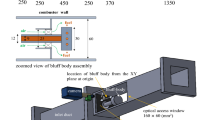Abstract
An experiment in a turbulent non-premixed flat flame was carried out in order to investigate the effect of swirl intensity on the flow and combustion characteristics. First, stream lines and velocity distribution in the flow field were obtained using PIV (Particle Image Velocimetry) method in a model burner. In contrast with the axial flow without swirl, highly swirled air induced streamlines going along the burner tile, and its backward flow was generated by recirculation in the center zone of the flow field. In the combustion, the flame shape with swirled air also became flat and stable along the burner tile with increment of the swirl number. Flame structure was examined by measuring OH and CH radicals intensity and by calculating Damkohler number (Da) and turbulence Reynolds number (Re T ). It appeared that luminescence intensity decreased at higher swirl number due to the recirculated flue gas, and the flat flames were comprised in the wrinkled laminar-flame regime. Backward flow by recirculation of the flue gas widely contacted on the flame front, and decreased the flame temperature and emissions concentration as thermal NO. The homogeneous temperature field due to the widely flat flame was obtained, and the RMS in the high temperature region was rather lower at higher swirl number. Consequently, the stable flat flame with low NO concentration was achieved.
Similar content being viewed by others
Abbreviations
- D :
-
diameter of the burner throat
- R :
-
radial distance
- R/D :
-
non-dimensional radial distance
- X :
-
axial distance
- X/D :
-
non-dimensional axial distance
- S :
-
swirl number
- S L :
-
laminar flame speed
- T :
-
instant temperature of the flame
- \(\bar T\) :
-
average temperature of the flame
- T′:
-
fluctuating temperature of the flame
- U :
-
radial velocity component of the flame
- V :
-
axial velocity component of the flame
- U avg :
-
air speed through the burner throat
- Da:
-
Damkohler number
- Re T :
-
turbulence Reynolds number
- υ′rms :
-
turbulent intensity of the flow
- δ L :
-
laminar flame thickness
- θ:
-
slit angle of a swirler
- σr :
-
ratio of the inner and outer diameters of a swirler
- υ:
-
dynamic viscocity
References
Hoffmann, S., Lenze, B. and Eickhoff, H., Results of experiments and models for predicting stability limits of turbulent swirling flames. Journal of Engineering for Gas Turbines and Power, Transactions of the ASME 120(2) (1998) 311–316.
Gupta, A.K., Lilley, D.G. and Syred, N., Swirl Flows. Abacus Press, Turnbridge Wells (1984).
Mathur, M.L. and Maccallum, N.R.L., Swirling air tests issuing from vane swirlers. Journal of the Institute of Fuel 41 (1976) 238–240.
Lee, S.N., Yun, H.G. and Ryoo, J.I., Flow field characteristics of a high load combustor. In: KSME Proceedings of Spring conference (B) (1996) pp. 58–63.
Chiger, N.A. and Yule, A.J., The physical structure of turbulent flame. AIAA 79-0217 (1979) pp. 1–8.
Hall, M.G., Vortex breakdown. Annual Review of Fluid Mechanics 4 (1972) 195–218.
Chaturvedi, M.C., Flow characteristics of axi-symmetric expansion. ASCE, Proceedings of the Hydraulics Division 89(HY3) (1963) 61–92.
Schmidt, S.E. and Hedman, P.O., CARS temperature and LDA velocity measurements in a turbulent, swirling, premixed propane/air fueled model gas turbine combustor. ASME 95-GT-64 (1995).
Ahmed, S.A., Velocity measurements and turbulence statistics of a confined isothermal swirling flow. Experimental Thermal and Fluid Science 17 (1998) 256–264.
Kwark, J.H., Jeong, Y.K., Jeon, C.H. and Chang, Y.J., The characteristics of the flow and combustion in a turbulent non-premixed flat flame. Transactions of Korean Society of Mechanical Engineers (B) 27(4) (2003) 447–457.
Adrian, R.J., Particle imaging techniques for experimental fluid mechanics. Annual Review of Fluid Mechanics 23 (1991) 201–304.
Lee, S.J., PIV-velocity field measurement. POSTECH (1999).
Chang, T.P., Image processing of tracer particle motion as applied to mixing and turbulent flow. Chemical Engineering Science 40(2) (1985) 269–275.
Armstrong, N.W.H. and Bray, K.N.C., Premixed turbulent combustion flowfield measurement using PIV and LST and their application to flamelet modeling of engine combustion. SAE No. 922322 (1992).
Huang, H., Dabiri, D. and Gharib, M., On errors of digital particle image velocimetry. Measurement Science and Technology 8(12) (1997) 1427–1440.
Yamaguchi, T., Turbulent diffusion flame in the shear flow. Transaction of JSME (B) 45 (1980) 981–990.
Gaydon, A.G., The Spectroscopy of Flames, Chapman and Hall (1957).
Devriendt, K., Van Look, H., Ceursters, B. and Peeters, J., Chem. Phys. Lett. 261 (1996) 450–456.
Glassman, I., Combustion, 2nd edn. Academic Press, Orlando (1987).
Reynolds, O., An experimental investigation of the circumstances which determine whether the motion of water shall be direct or sinuous, and of the law of resistance in parallel channels. Philos. Trans. Royal Soc. London 174 (1883) 935–982.
Turns, S.R., An Introduction to Combustion: Concepts and Applications. McGraw-Hill, New York (2000).
Metghalchi, M. and Keck, J.C., Burning velocities of mixtures of air with methanol, isooctane, and indolene at high pressures and temperatures. Combust. Flame 48 (1982) 191–210.
Abraham, J., Williams, F.A. and Bracco, F.V., A discussion of turbulent flame structure in premixed charges. Paper 850345, SAE P-156, Society of Automotive Engineers, Warrendale, PA (1985).
Author information
Authors and Affiliations
Corresponding author
Rights and permissions
About this article
Cite this article
Kwark, JH., Jeong, YK., Jeon, CH. et al. Effect of swirl intensity on the flow and combustion of a turbulent non-premixed flat flame. Flow Turbulence Combust 73, 231–257 (2005). https://doi.org/10.1007/s10494-005-4777-z
Received:
Accepted:
Issue Date:
DOI: https://doi.org/10.1007/s10494-005-4777-z




